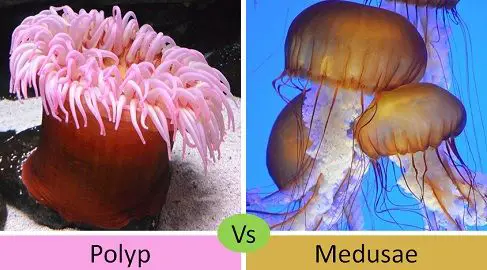

The phylum Cnidaria has about 13,000 different species. The cnidarians come into two basic forms – polyp and medusae.
The polyps are sessile tubular-bodied organisms which remain attached to the solid anchor like rocks. The main characteristic of them is the single, circular and terminal mouth that faces upwards to the water. They are primitive organisms that lack sense organs, velum and manubrium. The tentacles of polyps are located around the mouth region, forming a ring of tentacles in the upper body.
The medusae are the freely moving umbrella-shaped cnidarians. Their main characteristic is the 4-sided mouth that faces downwards. They are self-evolved species with photoreceptors, statocyst, velum and manubrium. The tentacles of medusae are present around the central body and hang downwards from the marginal ends.
This content explains the key difference between polyps and medusae in detail. So, let’s start.
Content: Polyp Vs Medusae
Comparison Chart
| Basis of Characteristics | Polyp | Medusae |
|---|---|---|
| Meaning | Polyps are the type of sessile cnidarians with a tubular-bodies. | Medusae are the type of free-floating cnidarians with saucer-like shapes. |
| Examples | Corals, hydra, sea anemones | Jellyfishes |
| Shape and Structure | The body of the polys is cylindrical in shape containing a long stalk. | The structure of medusae is saucer or umbrella-shaped with a reduced stalk. |
| Mobility | Sessile (Remains stuck in one place). | Mobile or Free swimming. |
| Mouth | Their mouth is single circular and terminal facing upwards. | They have a 4-sided mouth present at the lower end of the manubrium facing downwards. |
| Functional Role | Feeding and protecting their colonies. | Participation in sexual reproduction so as to distribute their species. |
| Habitat | They are presently attached to the rocks with watermarks. | They are located free-floating in open waters. |
| Reproduction | They can produce both polyps and medusae by the process of budding. | They can only generate medusae by sexual reproduction. |
| Method of Reproduction | Can reproduce both sexually as well as asexually. | Exclusively perform sexual reproduction. |
| Tentacles | Tentacles are present around the mouth ring. | Tentacles are present around the central bell that hang downwards from the margins. |
| Evolution | Primitive and simple as most of the advanced in the organisation are absent. | They are self-evolved and complex. |
| Gonads | Mainly, they lack separate reproductive organs or gonads, but they may produce gonads rarely. | They possess four gonads at the radical canal. |
| Adaptation | They have adapted themselves for a sessile or sedentary life. | They have adapted themselves to free-floating life. |
| Sense organs | They lack sense organs. | They bear sense organs. |
| Nerve cord | Absent | Present |
| Manubrium | Absent | Present |
| Velum | Absent | Present |
Polyps
Polyps are the first of the two types of cnidarians. Their main characteristic feature is the presence of a ring of tentacles around the mouth. They are sessile cnidarians which remain anchored at one position.
Polyps are tubular-bodied organisms with a free upper end and fixed bottom end. The mouth and tentacles face upwards to the water. They can be solitary such as sea anemones or can be colonial, like corals.
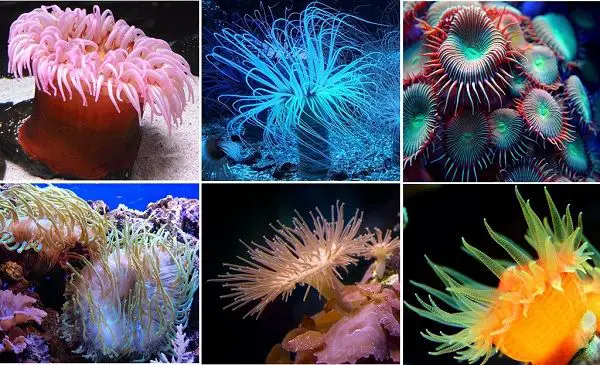

Habitat
They are sessile cnidarians that remain anchored to the substrate by the adoral end. The anchor is mainly rock or solid corals. They attach via a pedal disc which is a disk-like holdfast.
Types of Polyps
- Hydrozoan: It is the class of polyps that includes organisms with simple body organisation. Example: Hydra.
- Anthozoans: These polyps have complex body organisation. Example: Corals and sea anemone.
The class anthozoans possess tubular stomodaeum which begins from the mouth and extent up to the gut. They can reproduce asexually. But very often they undergo sexual generation, by which they get modified into medusae.
Body Wall
The body of a polyp is just like a sack. Their body wall is composed of two cell layers. The outer layer is the ectoderm, while the inner layer is the endoderm. We also refer to endoderm as gastrodermis as it encloses the stomach region.
A supporting layer is present between the ectoderm and endoderm, known as mesoglea. The mesoglea is made up of structureless gelatinous material that is released by the cell layers of the body wall. The thickness of mesoglea may vary, i.e. it can be very thin or can be fairly thick. Often, it bears skeleton components formed by cell migration.
Structure of Polyps
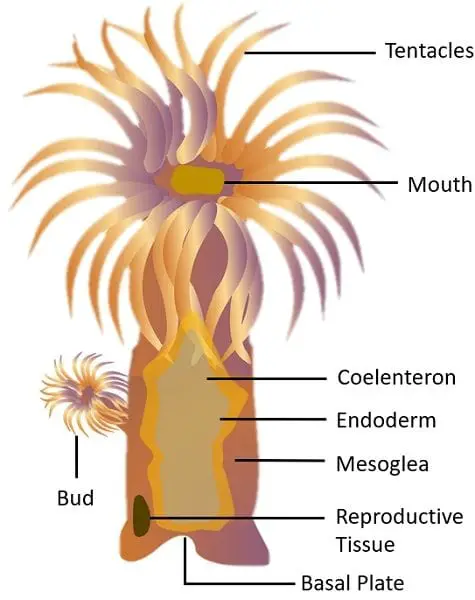

The polyps have two different ends – upper end and lower end.
- Upper end: It is a free end that is not attached to any surface. Here, there are several extensible tentacles around the mouth. These tentacles are finger-like structures that have a specialised structure called nematocytes. Nematocysts are also known as stinging cells. They are responsible for carrying the prey by secreting the paralysing chemical, thereby facilitating the food intake for the polyp.
- Lower end: It remains attached to the solid anchor since the polyps need support. The polyps lack the mechanism of locomotion, due to which they have to be in one place. The basal plate is the part that attaches at the attachment region end.
Trunk
- There is a long tubular trunk lying between the upper end and lower end. It has a coelenteron in the middle of the body, which is a gastrovascular cavity for circulation and digestion purposes.
- Gastrodermis comprises a single exterior opening. Therefore, the intake of food from the mouth and the excretion of waste from the anus occurs through the same single opening.
Medusae
The medusae are the second type of mobile cnidarians; thus, they keep swimming the entire water body. We consider them soft bodies due to their gelatinous appearance. The external appearance of medusae is just like an umbrella or saucer with numerous filaments hanging from it.
The umbrella-like upper bell has the ability to perform muscular contractions. This helps in acquiring propulsion and locomotion for swimming.
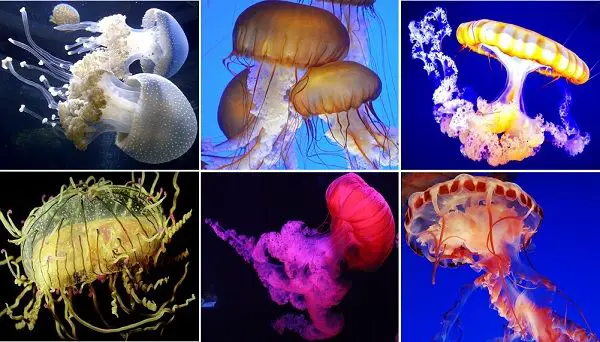

The hanging filaments are nothing but tentacles. These trailing tentacles are very helpful to the medusae as they play a part in capturing the prey as well as defending them against predators. There are several different types of tentacles present according to the different species. They also bear several receptors like photoreceptors, statocysts (Gravity receptors) etc.
Mode of Reproduction
The mode of reproduction in medusae is mainly sexual, yet their development process varies with different classes. For instance, the class hydrozoan is developed by budding. The class Cubozoan or Rhizostomae was developed by the metamorphosis of a polyp.
Body Wall
The medusae also have an outer layer as ectoderm and an inner layer as endoderm. And in between them is a thick mesoglea.
Structure of Medusae
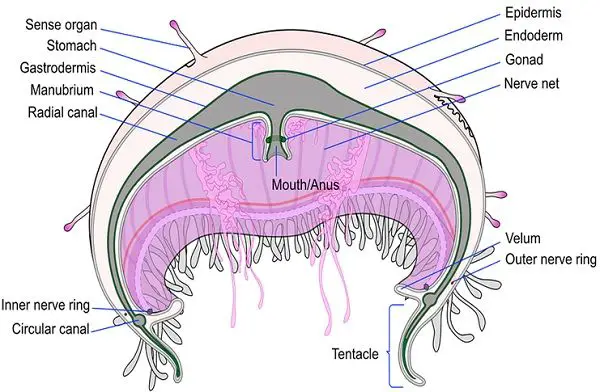

Central Bell
- The central bell comprises a mouth which opens into the enteron and interconnects to the radial canal. The mouth region remains encircled with several hollow tentacles bearing nematocysts.
- The mouth opens into the gastrovascular cavity, which is present as a branched network of canals.
- Scyphozoans possess a net of nerve cells. However, the large net controls swimming while the smaller net regulates feeding and spasm.
Tentacles
- They remain hanging from the edges of the bell. These tentacles have nematocyte cells containing the chemicals that kill or paralyse their prey.
Key Differences Between Polyp and Medusae
- Polyps are sessile bodies, while the medusae are free floating.
- The polyps remain attached to a solid anchor, mainly to the rocks. The medusae on the other side remain freely floating in the water.
- The shape of the polyp is tubular, whereas medusae are umbrella-like, saucer-like, or bell-like.
- Sense organs are absent in polyps. But sense organs like photoreceptors and statocysts are present in medusae.
- The mouth of the polyp faces upwards, while that of the medusae faces downwards.
- The manubrium is absent in polyps but present in medusae.
- Polyps can reproduce sexually or asexually. In contrast, the medusae can reproduce only via sexual reproduction.
- Polyps can generate both polyps and medusae. But the medusae are only capable of producing medusae after reproduction.
- Velum is absent in polyps by present in medusae.
- Polyps are primitive and have simple organisation. Conversely, the medusae are self-evolving and thus have complex body organisation.
- The nerve cord is absent in the polyp while present in the medusae.
- The prime function of polyps is to feed, protect their colonies and reproduce. While the medusae mainly focus on the sexual reproduction and distribution of their species.
- Polyps have adapted themselves to living a sessile and sedentary lifestyle. In comparison, the medusae have adapted according to their free-floating nature.
- Hydra, corals, and sea anemones are examples of polyps, while jellyfishes are examples of medusae.
Conclusion
The phylum Cnidaria comprises hydroids, sea anemones, corals, jellyfish etc. Together this phylum aids in upholding the diversity of the underwater organisms by playing the roles of food, predators and shelters for other organisms like filter feeders.
The polyps and medusae are the two types of Cnidaria whose appearance, way of functioning as well as habitat; all differ from one another. Here, you will get a detailed idea of the major characteristic difference between these two types.


2 Comments
o3o8gt
k3j8rc